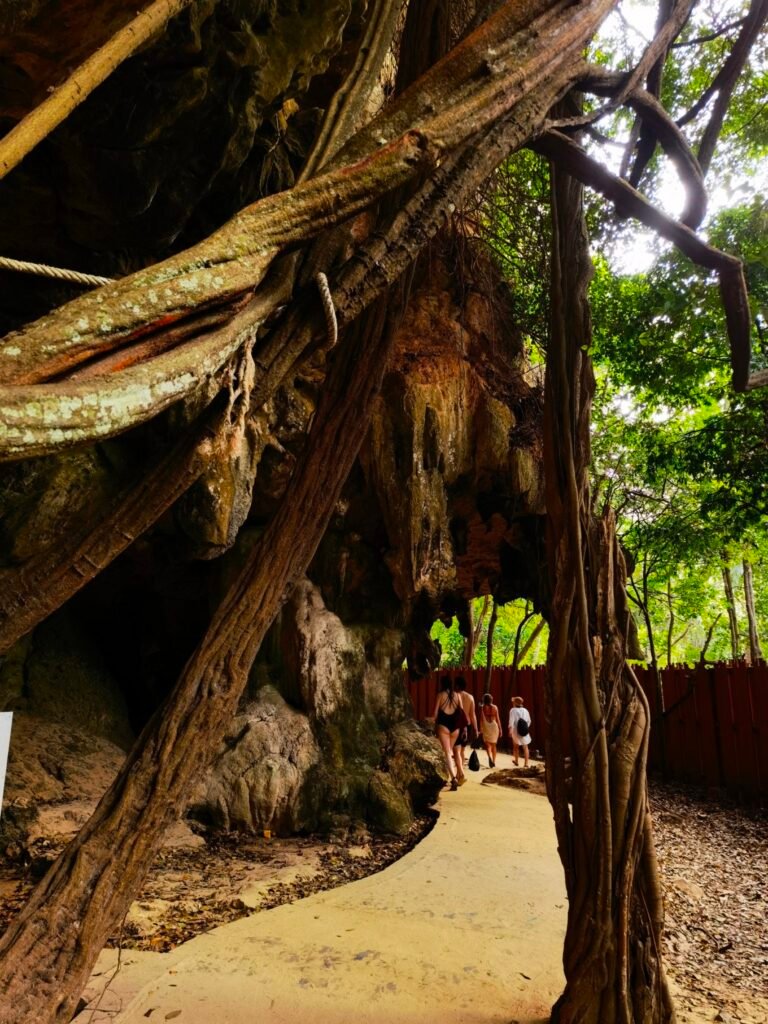On my first day at the hotel in Krabi, I woke up early—it seems I’m not destined for sleeping in. Breakfast at the hotel doesn’t end until 11 a.m., so everyone leisurely slows down, easing the tension of daily life. The restaurant was packed with guests of all skin tones and languages, and it was the peak breakfast time. There were hundreds of options—Thai, American, Indian, and more. I only grabbed some bread, butter, chicken soup, rice noodles, and curry chicken. It seemed my stomach hadn’t fully recovered from last night’s Thai seafood feast and wasn’t ready for more. But after a final plate of fruit and a cup of coffee, I felt my energy officially return.


Breakfast basically turned into brunch. Under the scorching midday sun, kids were happily playing in the first-floor circular pool, unfazed by the heat. The lounge chairs under the umbrellas were mostly occupied by attractive people. We made our way back to the room and immediately laid down in the comfort of the air-conditioned room, fully relaxing in whatever way felt best. We waited until the sun cooled down before starting any activities.
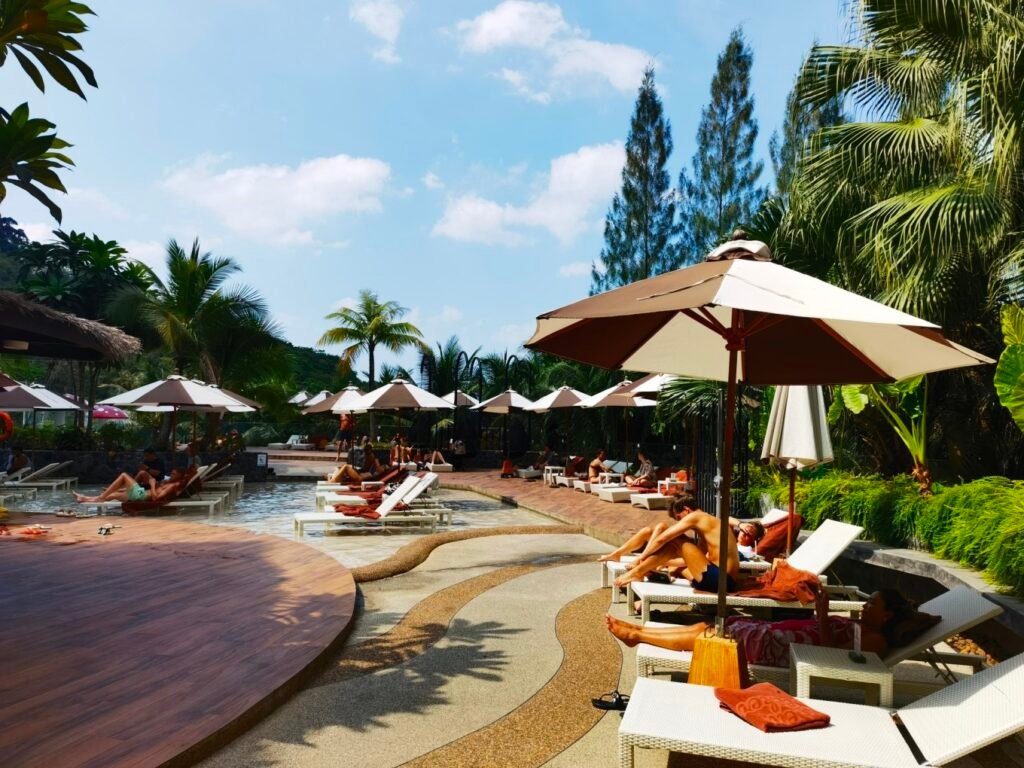
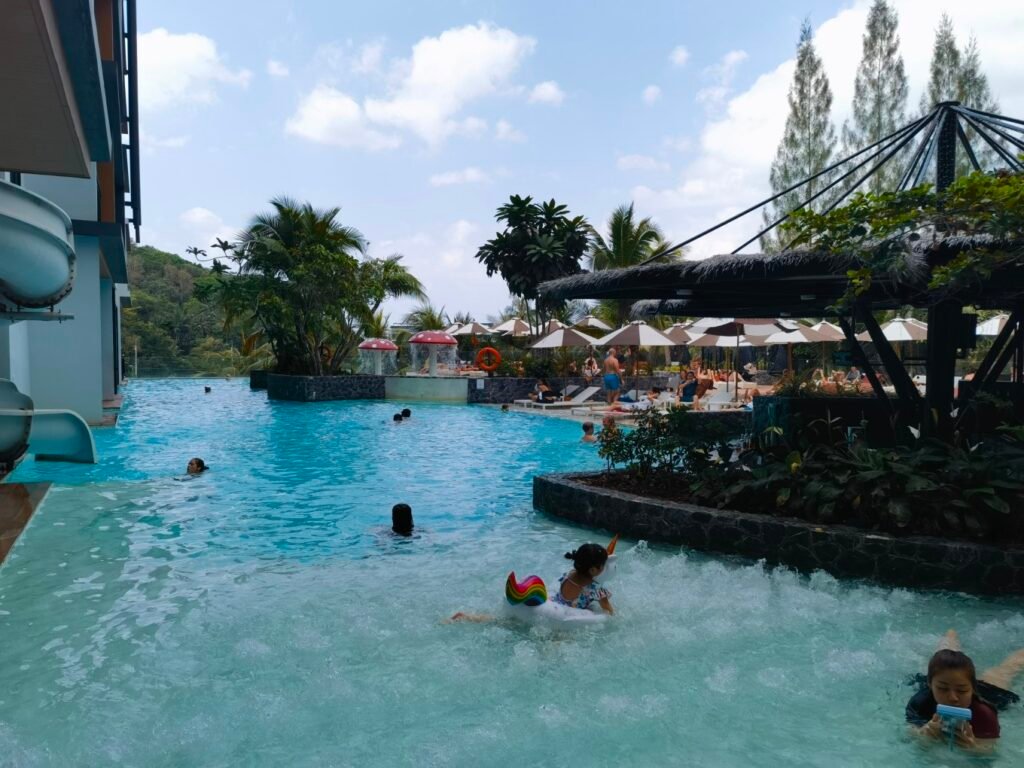
At 4:30 in the afternoon, the scorching sun was also getting ready to call it a day. A few of us were gearing up to head to the beach.

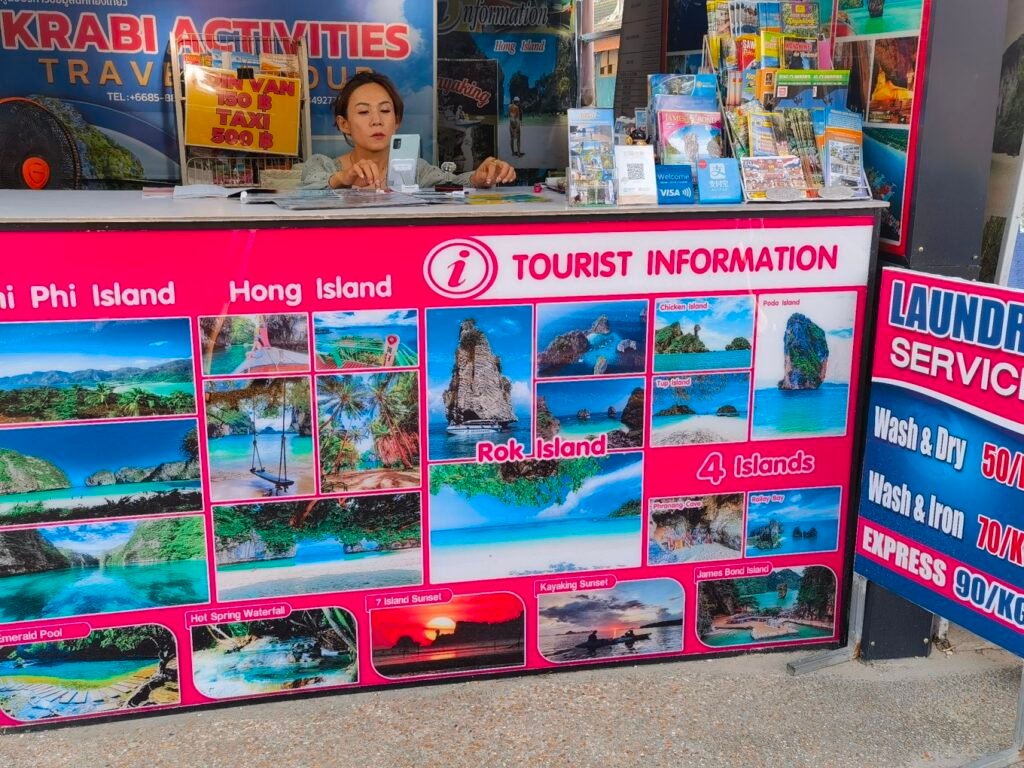
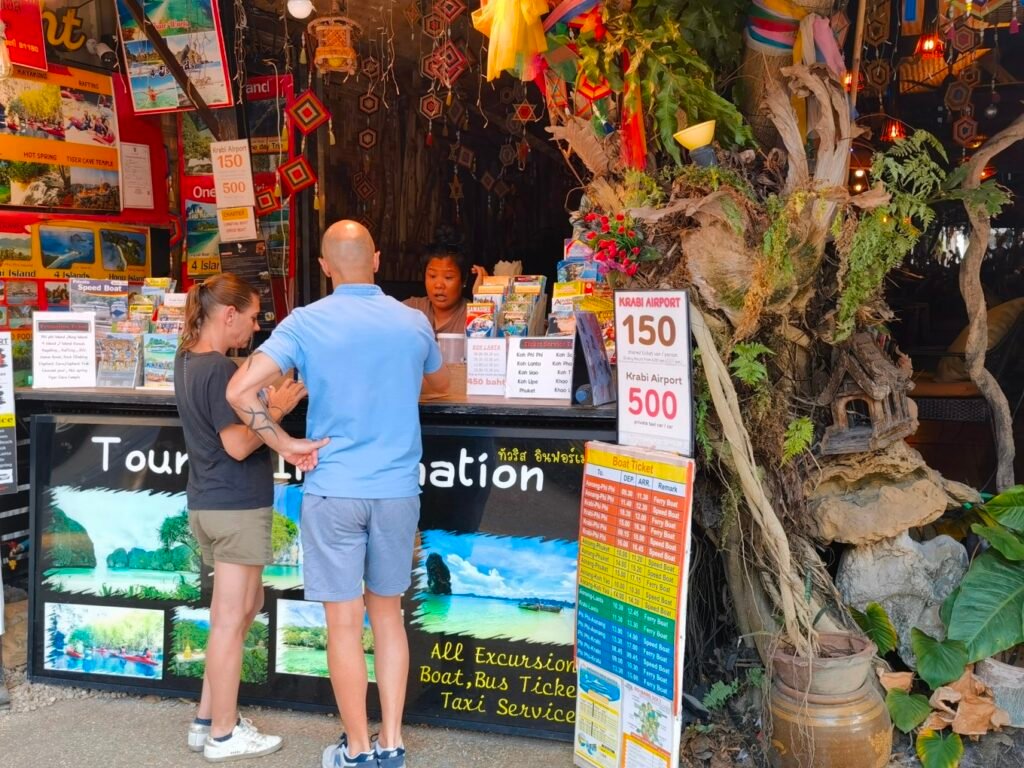
A left turn out the door, then a right, and after about 10 minutes, we arrived at Ao Nang Beach. The late afternoon sun was gradually turning red and soft. On one side, massive rock formations jutted out into the sea, while on the other, long-tail boats with their arched bows and sterns gathered on the distant and near waters. The sunset bathed the mountains, sea, and boats in golden light, with the shimmering waves sparkling beautifully. Coconut trees swayed gently along the seaside walkway, and relaxed tourists added to the scene—a truly breathtaking and captivating view.
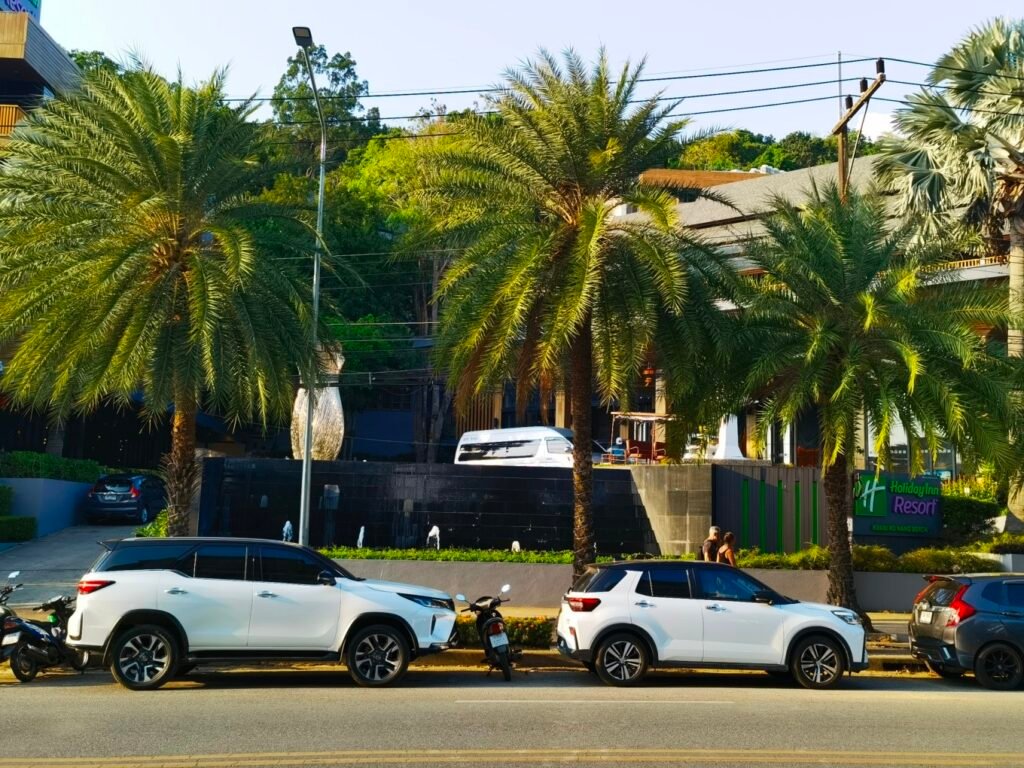

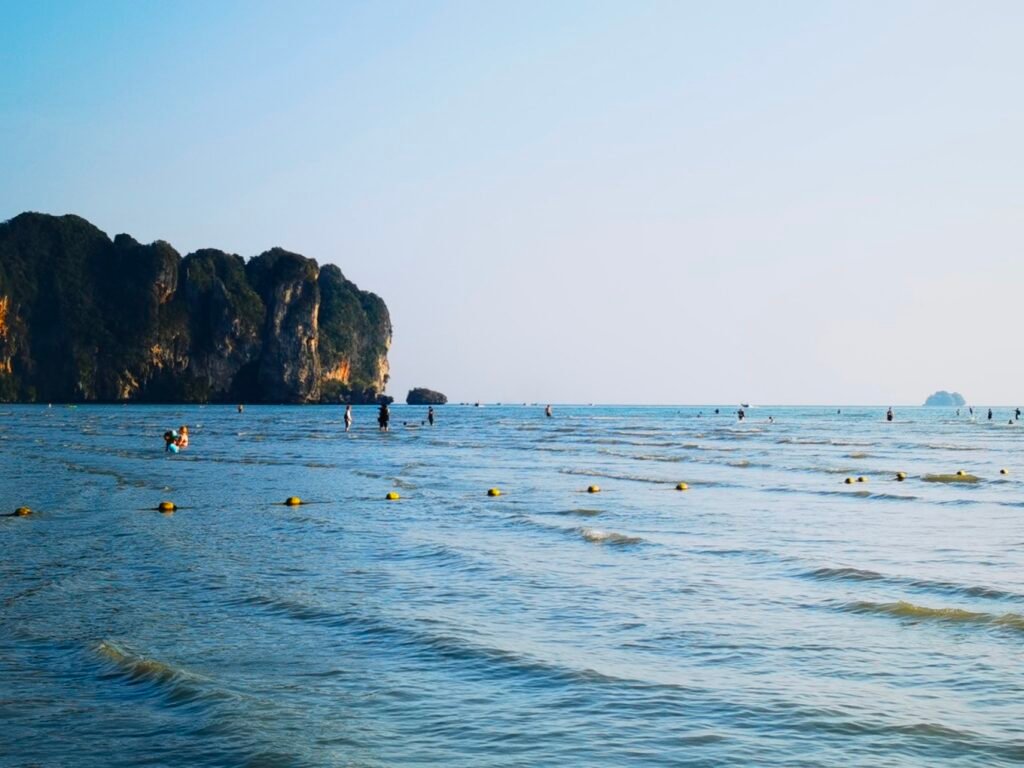


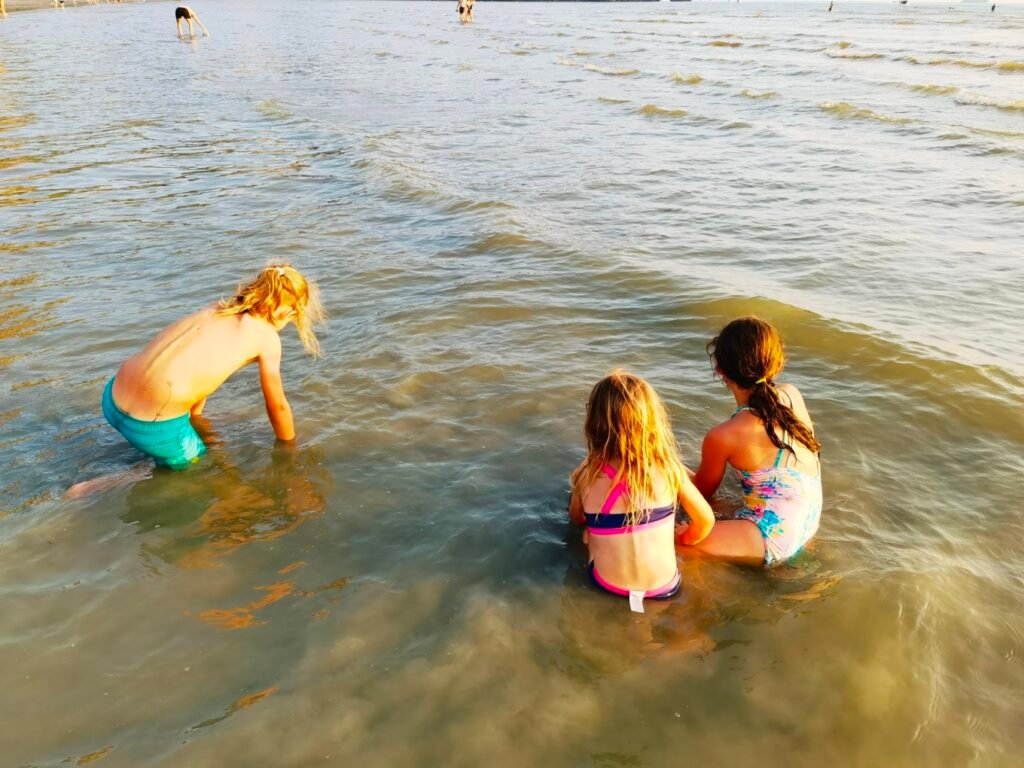
Ao Nang Beach Road has the beach on one side and hotels on the other. At the time, we didn’t know that the hotel we’d be staying at for the next few days was among them.
It happened to be a Saturday, and we heard there was a special night market in Krabi Town, so we figured we came at the perfect time—how could we not check it out? The roadside songthaews (shared taxis) stop at a wave, and for 50 baht per person and a 30-minute ride, we arrived at the night market entrance next to the Vogue Shopping Center in Krabi Town. A sense of familiarity washed over us—Thai handicrafts, clothes, shoes, food, and drinks brought back memories of our previous trips to Thailand. Oh, how we’ve missed the lively, everyday Thai life! It made us wish that all the wonderful and happy moments in life on Earth could continue endlessly, passed down from generation to generation.
A pleasant surprise was stumbling upon a popular sushi stall among the countless vendors. We indulged in a variety of seafood sushi at incredibly affordable prices. Satisfying the foodie in us felt like fulfilling everything we could ask for.


The bustling night market, filled with visitors from all over the world.






A Thai coloratura singer with a wonderfully unique voice.


As usual, I didn’t sleep in the next morning. But after finishing breakfast around 10 a.m., the blazing sun made it hard to venture outside. Staying in the room scrolling through my phone gave me a strong sense of guilt, especially seeing everyone else fully enjoying themselves. It made me determined to get out of the comfort of the hotel!
I decided to gather my gear and get ready to hit the sea!
Following the advice of other bloggers, we waited until the afternoon sun had softened a bit. Then, from the other side of the hotel, we accidentally stumbled upon a quiet path that led us straight to the best sunset viewpoint at Ao Nang Beach, near Monkey Trail. It turned out to be a shortcut we hadn’t expected to find.
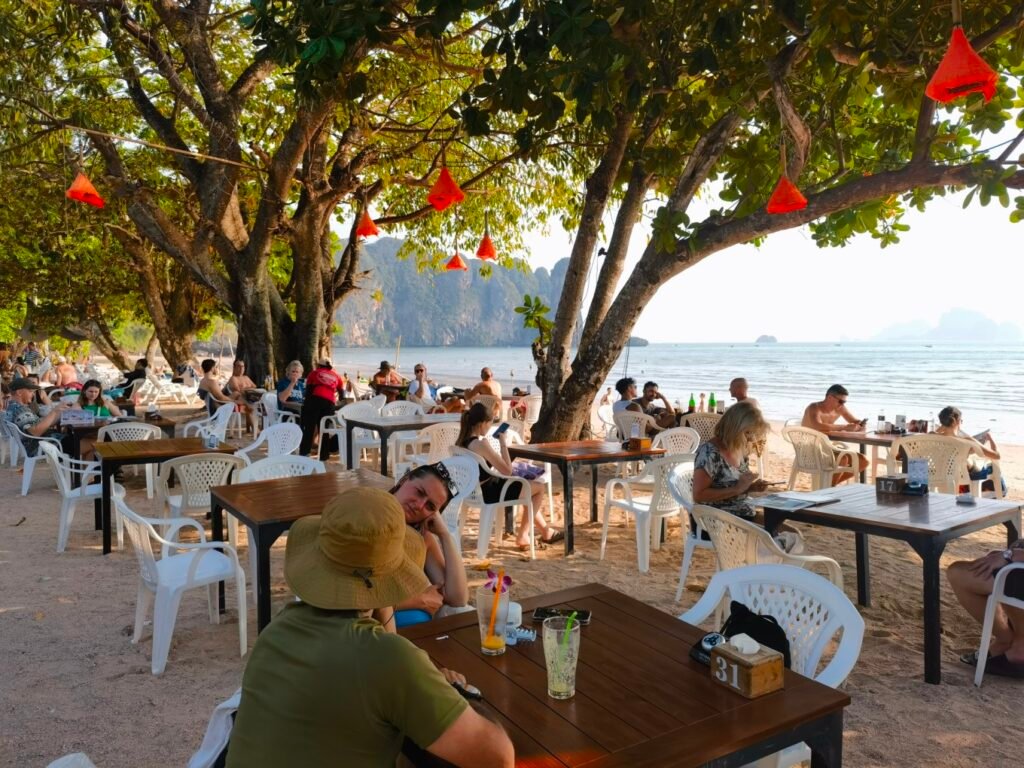

The cliffs in the distance seemed so close, yet we didn’t know how to reach them. We saw some people climbing a path toward the mountains, so we followed them on an adventure. Along the way, monkeys kept leaping out to play with the visitors, and one cheeky monkey even managed to steal my map, easily pulling it out of my bag since I hadn’t zipped it properly.
My girlfriend and I were drenched in sweat by the time we reached the secluded, untouched little bay on the other side of the cliffs. Just as we were about to step onto the beach, we saw the group ahead of us casually collecting shells in the waves, less than 50 meters away. It turns out you could reach the same spot by simply walking around the bend along the beach! It just goes to show that sometimes success isn’t directly proportional to the amount of effort—you’ve got to choose the right path.




The floating dock closest to Monkey Tail Rock can accommodate long-tail boats, and the scenery nearby is stunning. Unfortunately, the tide came in later, and we didn’t have a chance to return.

On the way back, we came across a street musician.
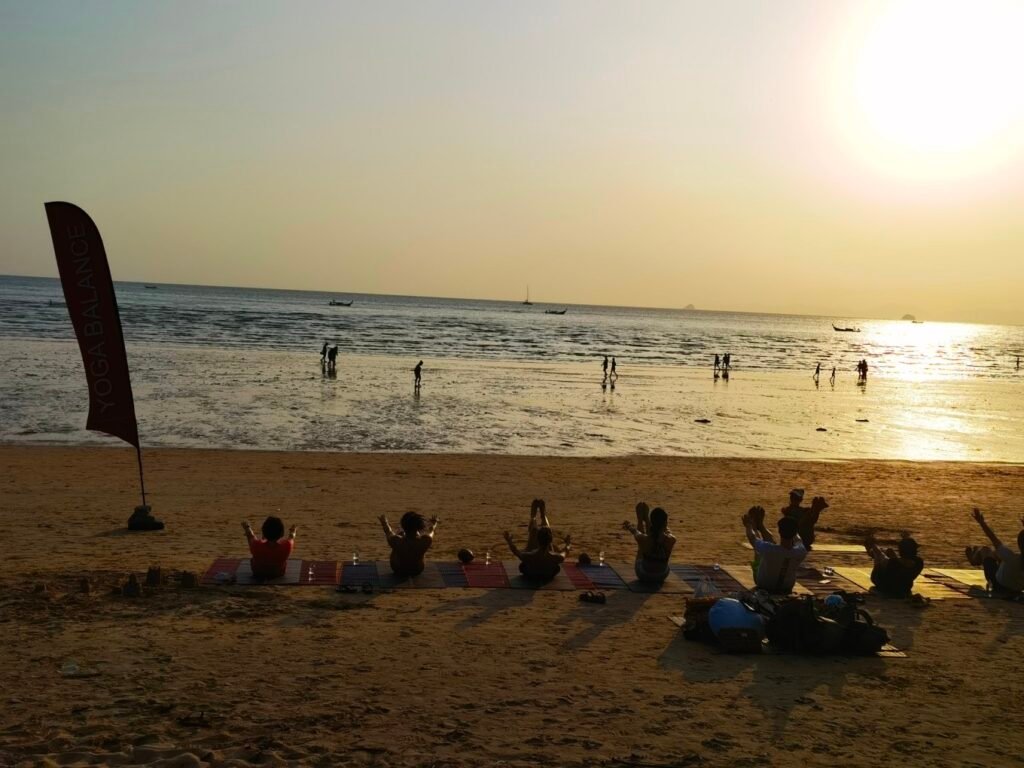
A group of people practicing yoga on the beach.
In the evening, we grabbed dinner at the brightly lit little night market’s FOOD CENTER. Prices were cheap—the fried rice and noodles were pretty good, but the fried shrimp cakes were the best. After getting back to the hotel, I swung by the travel agency desk next to the front desk and booked tickets for the next day’s island-hopping tour—a one-day trip to Phi Phi Island for 1,400 baht per person, including boat tickets and lunch. Honestly, the itineraries and prices at all the travel agencies up and down the street are pretty much the same. Keeping things simple and efficient—that’s a principle we need to stick to during our travels.
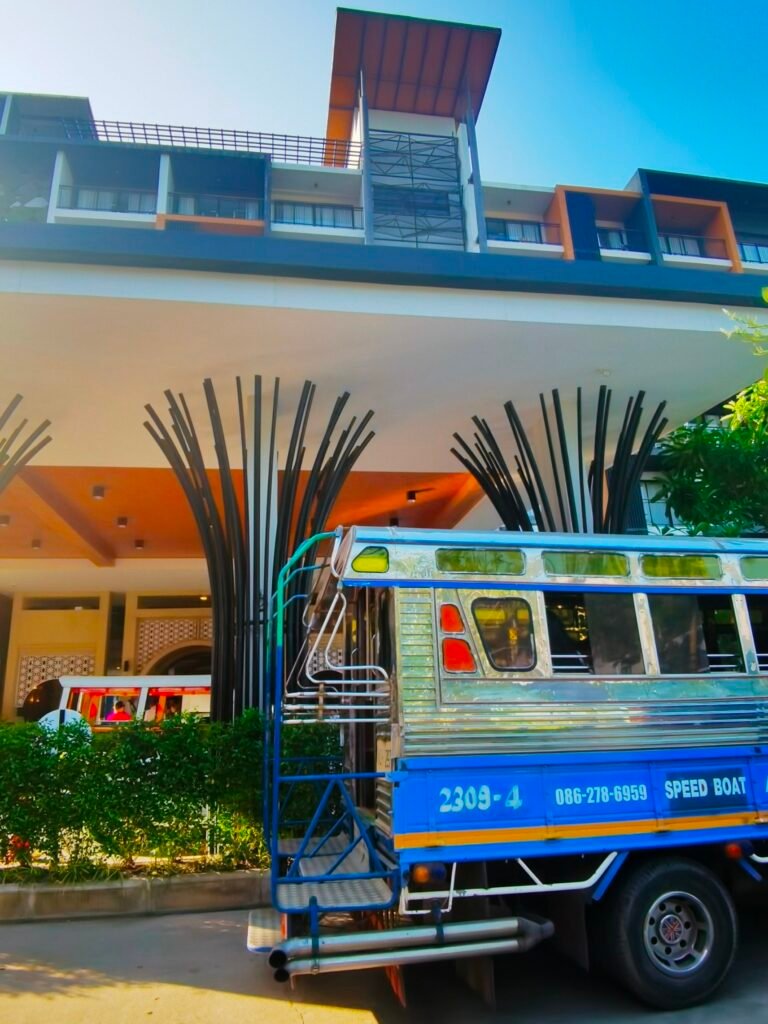

The three songthaews picked up thirty to forty passengers along the way, definitely exceeding the number specified in the contract. I was a bit annoyed but didn’t get angry—life’s tough enough already. At 9:30, we finally boarded the speedboat at the departure pier.
The one-day Phi Phi Island tour is the top island-hopping route here. Along the way, it includes stops at Bamboo Island, Big and Small Phi Phi Islands, Hong Island, Viking Cave, Maya Bay, Piak Bay, Monkey Beach, and other spots. Whether it’s hiking on the islands or stopping the boat for photos, there’s also time set aside for swimming, snorkeling, and lunch, showing just how packed the schedule is. I hadn’t been on a group tour like this in a long time, but my experience was still there. The key was to clearly understand the duration of free time and the boat return time, then meet up on time.
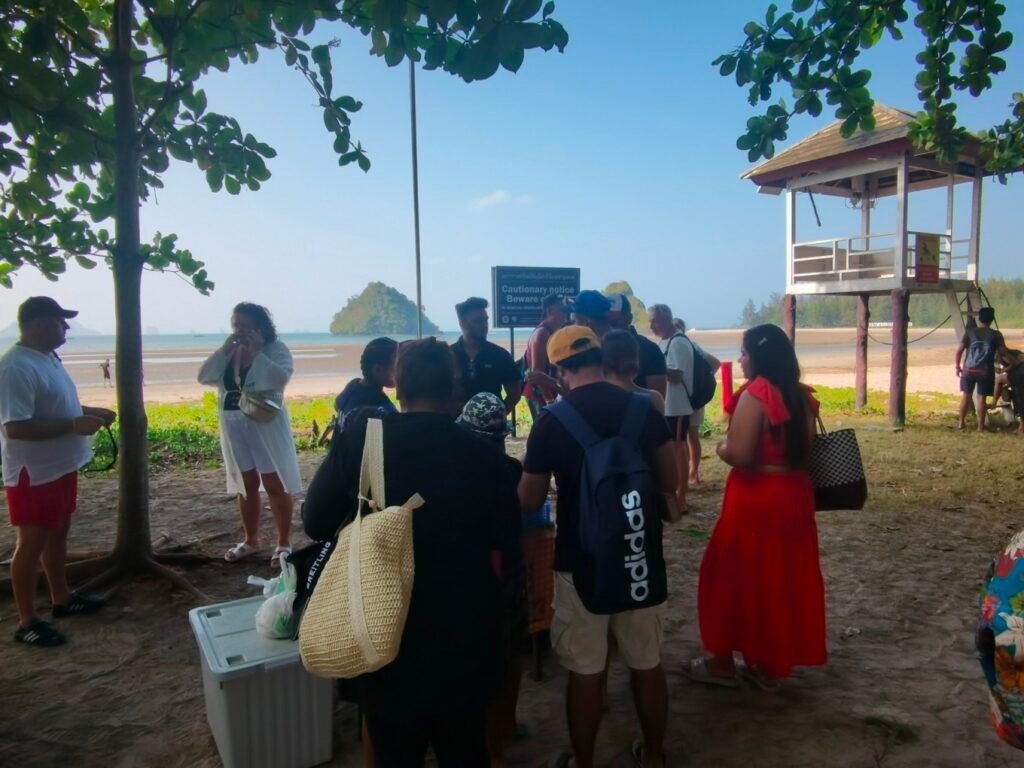

After arriving at the pier, the staff handed out wristbands and went over safety instructions. The speedboat was packed to capacity.
First Stop: Koh Phi Phi Noi
It’s not a big island, but it does have a lovely forest park.
I’ve been to quite a few Southeast Asian islands and beaches—Maldives, Bali, Phuket, Lombok, Boracay, Mui Ne, Pattaya, Hua Hin, and the list goes on. You can’t say I haven’t seen some absolutely stunning clear waters and fine sands. But when the speedboat approached the Koh Phi Phi Noi pier and Maya Beach, I was genuinely blown away by the emerald-green, deep blue, crystal-clear seawater here. The sea breeze was blowing the waves toward the shore, making them look like flowing jade. I joyfully dove right in, instantly feeling like I was back at 18.

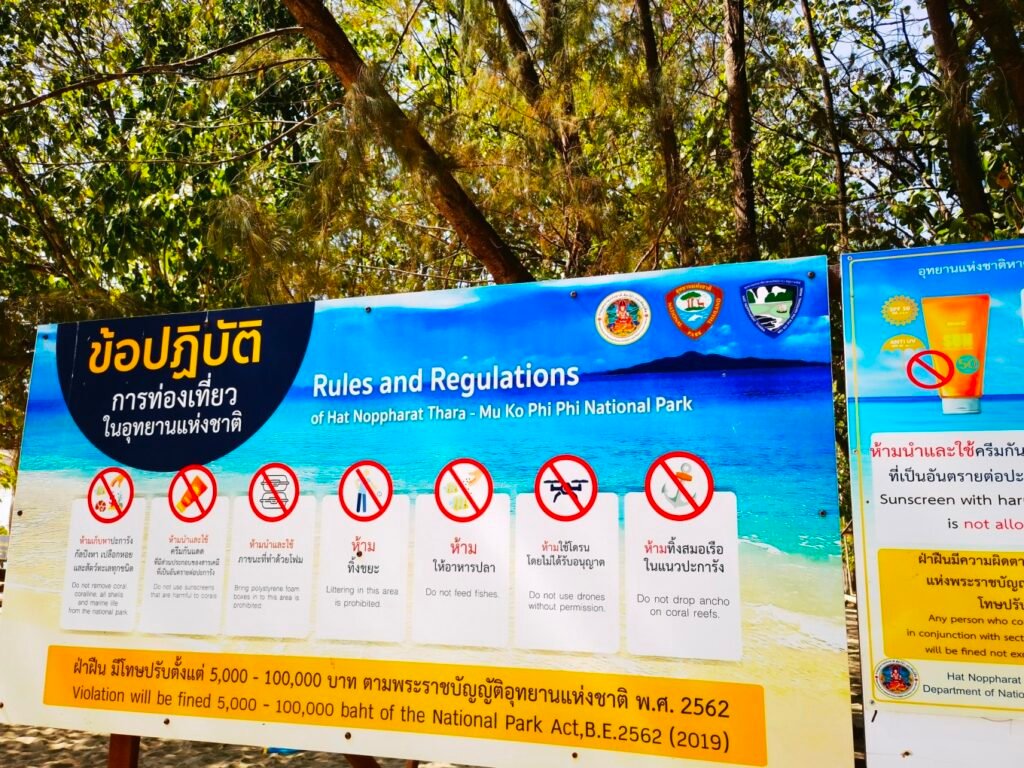


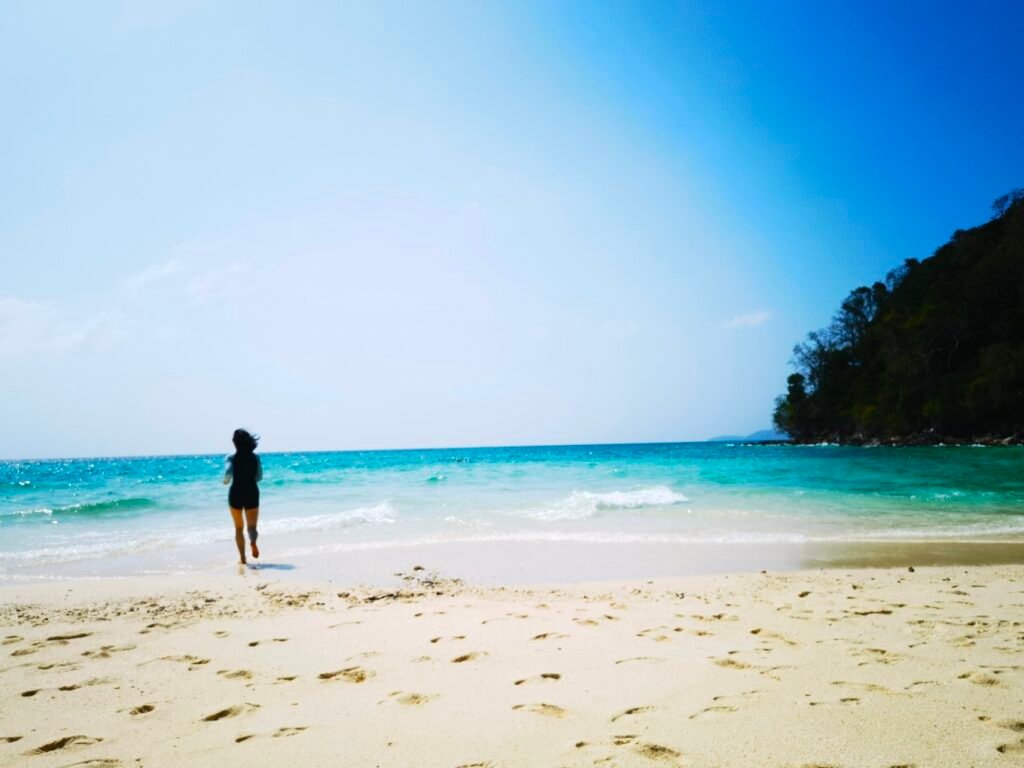
We sailed to another island: Hong Island and Maya Bay.

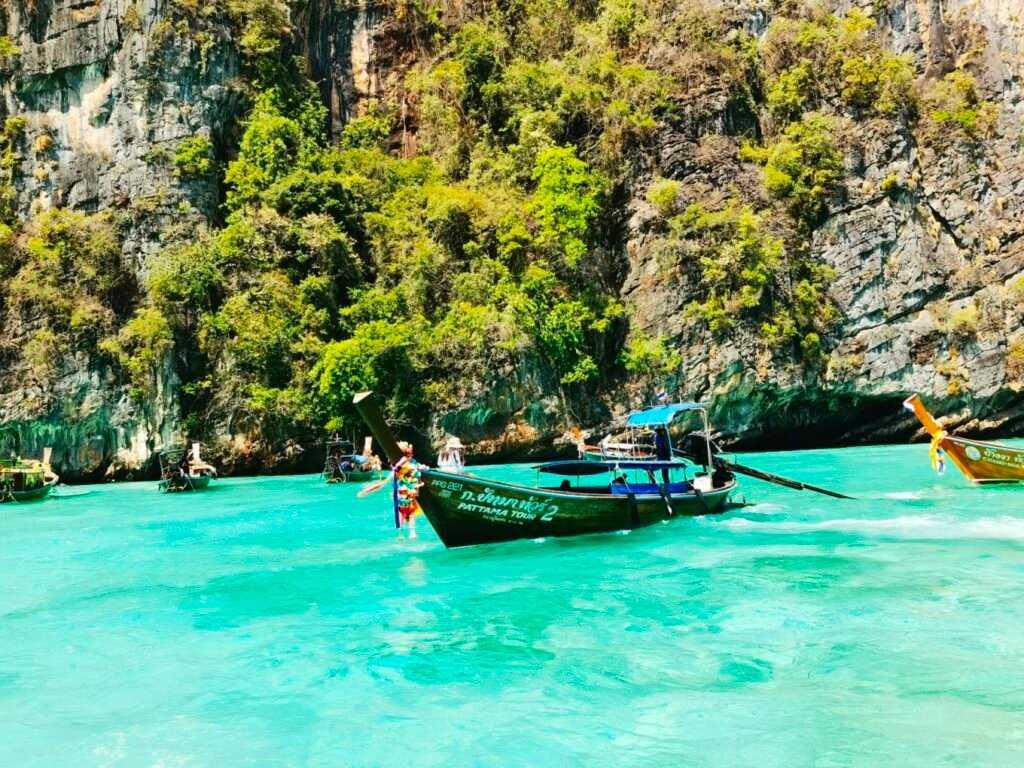


Lunch was served in the heart of Big Phi Phi Town, clearly designed for group dining. The restaurant was semi-open, tall, and bright, able to accommodate two to three hundred people at once. Between the tables on either side were rows of counters stocked with fried rice, fried noodles, stir-fried vegetables, stewed meats, curry soups, salads, and more—everything looked absolutely enticing. But when it came to eating, I was stuck because everything was too sweet. After having a few pieces of boiled potatoes and half a bowl of rice drenched in chili soy sauce, I decided to leave the restaurant and sat down on the powdery white sand beach. Facing the sea, I watched the gradient of colors shift from creamy white to light green, pale blue, deep blue, navy, and finally to inky black. The soothing breeze felt like an angel’s touch, gently brushing my hair and calming any restless emotions.


Whether swimming in the crystal-clear, creamy waters of Hong Island’s beach or snorkeling in the Blue Lagoon surrounded by cliffs, I never missed any activities. No matter how much photographers or kids yelled and tried to stop me, I always joined in, becoming one of those “enthusiasts” among a mix of Indians, Americans, Chinese, Germans, Koreans—basically people from all over the world. With the tour guide’s help, I even improvised my snorkeling gear by pairing my prescription goggles with the boat’s snorkel hose to meet my severe nearsightedness needs: I wanted to see the sea floor and little fish while still being able to breathe normally. The result? After 20 minutes of snorkeling, my stomach was in serious distress. I grabbed an empty plastic bag and ended up puking everything out of my stomach. Afraid of disturbing everyone, I quickly sealed the bag and carefully stuffed it into my backpack before dozing off amidst the boat’s bumps.
Back at the hotel, I was surprisingly feeling refreshed and knew I had to have a proper dinner to soothe myself and those who didn’t go out to sea. So, following tips from the all-purpose app Xiaohongshu, I found a “food center” in a small alley off the bustling main street to the right of the hotel. It was pretty quiet—we were the only table there. After ordering and making sure to emphasize that all dishes had to be “no sugar,” our meals arrived in no time. When we tasted the food, everyone was thrilled: it was just like “the taste of home”! Plus, the prices were super cheap—only $10 per person! The best meal we had since arriving in Krabi! We regretted not discovering it sooner and made sure to grab some local beer too! Unfortunately, the wind swept away all the delicious food, leaving no trace of our feast in a single photo. That night, I slept extra soundly.
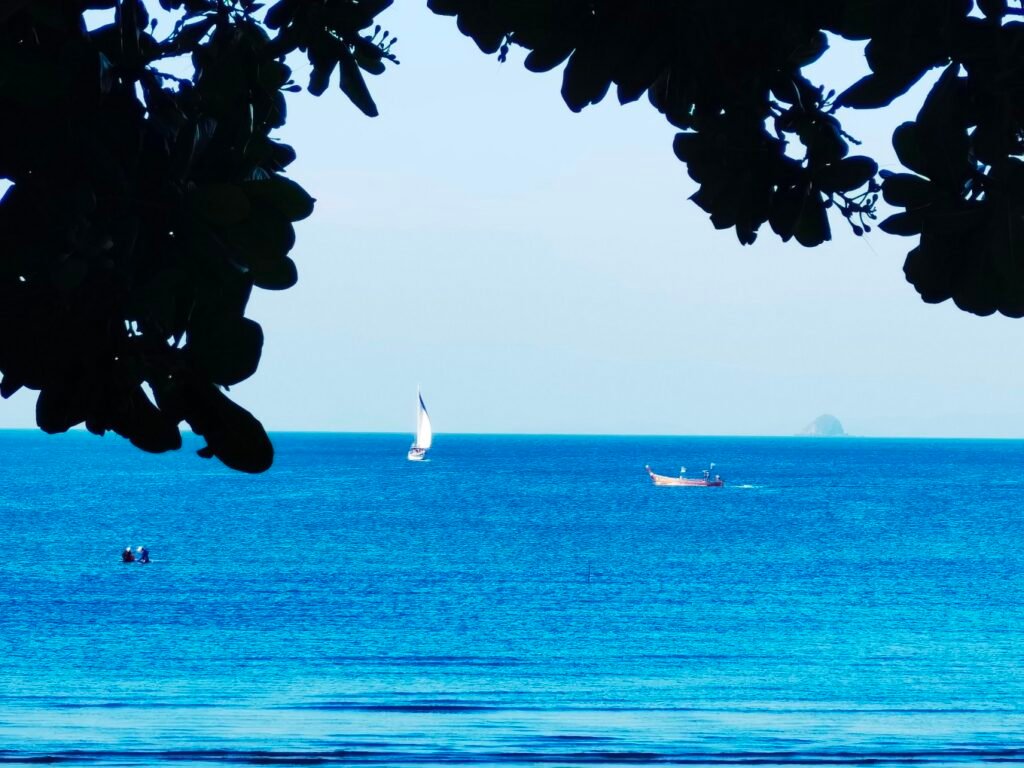

Early on the fourth day, I woke up naturally to the sound of the ocean waves. Every time I vacation by the sea, I can’t help but not want to sleep in because these beautiful experiences are so precious—I want to savor every single minute and second. In the future, on some ordinary day, these wonderful memories will bring me so much warmth.
The breakfast options weren’t as extensive as at SEA SEEKER, but they seemed to suit my tastes better: fried noodles, seafood congee, omelets, stir-fried vegetables, fruit salads, and more. The restaurant faced the ocean directly, just 30 meters away. With the salty sea breeze, the lazy sound of waves crashing onto the beach, and the long-tail boats bathed in golden morning light not far away, I often found myself daydreaming, momentarily forgetting where I was.


At nearly noon, under the blazing sun, the sea was teeming with people. All I could think about was, “Let’s go into the water! Let’s go into the water!”
Swimming in such intense, scorching sunlight for the first time made me truly appreciate the magic of midday seawater: there’s no noticeable shift between hot and cold, just gentle breezes and soft waves. Everything wraps around you with warm, soft affection. Lying on the sea surface, drifting with the waves, it felt like sleeping on a giant waterbed.
Since we had a countryside tour booked for the afternoon, our sea swim had to be cut short—but there’d be another chance tomorrow.
The driver was incredibly reliable, waiting for us right on time at the hotel entrance and didn’t mind if we gathered a bit late, which really touched me. So, three trips to Krabi Town: first, exploring the night market; second, climbing Phi Phi Island; third, visiting caves and the countryside.
Our first stop was the caves on Koh Gai (Rooster Island). We had to take a long-tail boat through the mangroves along the river. The calm river often had semi-fixed docks and boats where families lived, and even some luxurious yachts anchored in the middle of the water, blending in seamlessly. The long-tail boat turned from the wide river into the narrow channels, and the mangroves on both sides were tightly packed and lush. The tangled tree roots looked like natural wooden stakes surrounding the sides of the channels, allowing boats to pass through, as if navigating through a primeval forest.
Rooster Mountain is just a typical rocky hill found in karst landscapes, with dense forests. Halfway up the mountain, there are huge rock caves where Japanese soldiers were stationed during World War II. Primitive human remains have also been found here. The rugged terrain, caves within caves, historical legends, and the lack of human footprints added a sense of adventure to our exploration.
Upon arriving at the temporary floating dock on Koh Gai Island, we didn’t have to walk far before entering the visitor trail. The jagged mountains and rocks on both sides were covered in dense trees, making it feel like a jungle adventure.

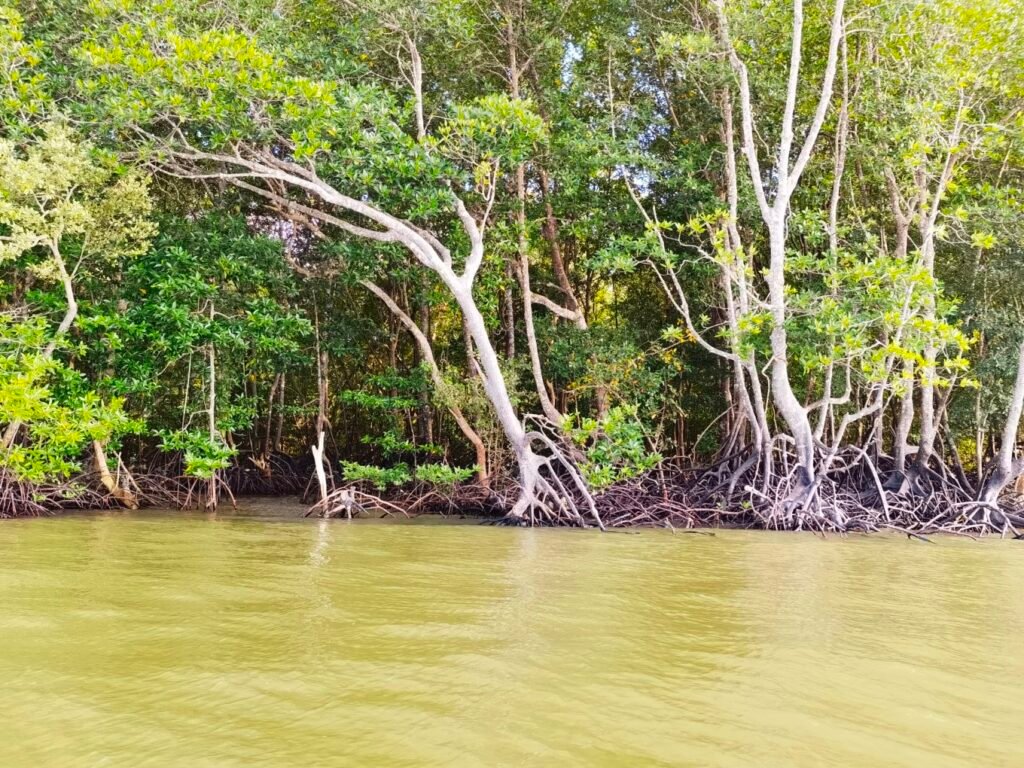




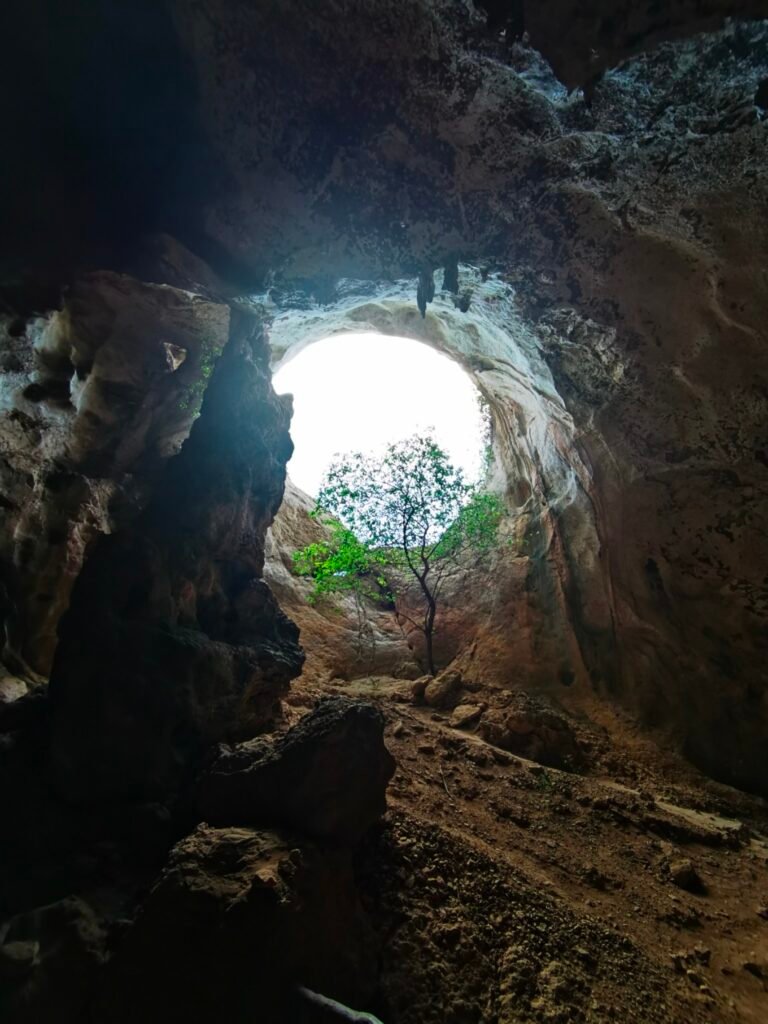
After taking a boat back from the island to the starting pier in Krabi Town, two tuk-tuks led us on a genuine rural tour showcasing everyday Thai life: simple stilted wooden houses, coconut trees heavy with fruit, contented cows and sheep, barefoot boys running on uneven natural soccer fields, and winding inland waterways. It was a bit dirty and messy, but at the same time, it was peaceful and serene.
Halfway through the tour, the driver stopped in front of a house with a simple wire fence and pointed to the coconut trees around the property, asking if we wanted some coconut water. We totally needed it! So everyone got off to explore the farmyard and the small pond, played with the chickens and ducks in the yard, and watched the homeowners harvest coconuts right there. Unfortunately, the tools broke after picking just three coconuts, and the owner looked really worried because we had asked for ten. There wasn’t time for him to fix the tools, so we paid up, sincerely thanked him, and kept assuring him it was okay. Only then did he and his wife clasp their hands and say, “Khab Khong Kha~”. Such kind people—wishing you all the best.
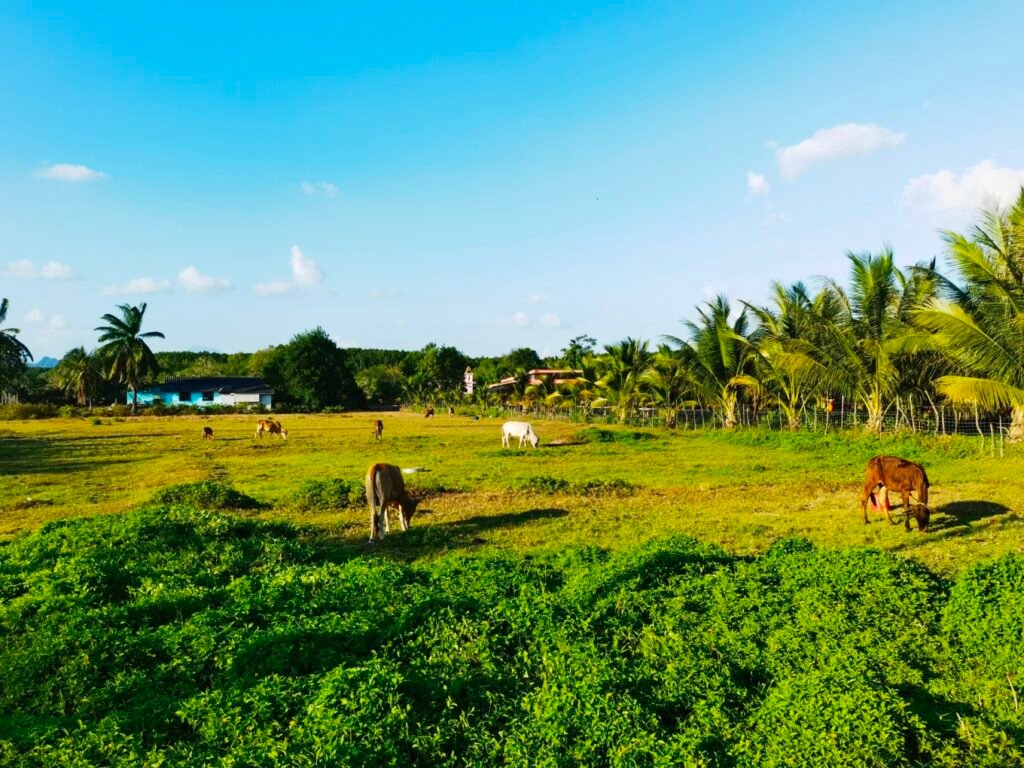
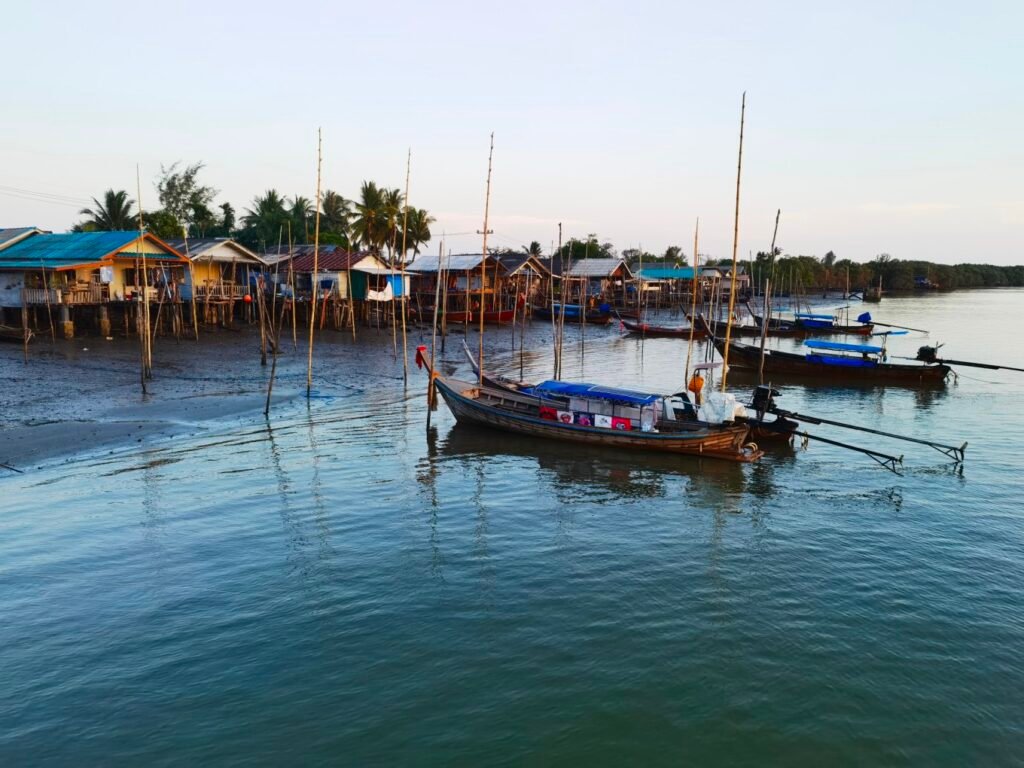

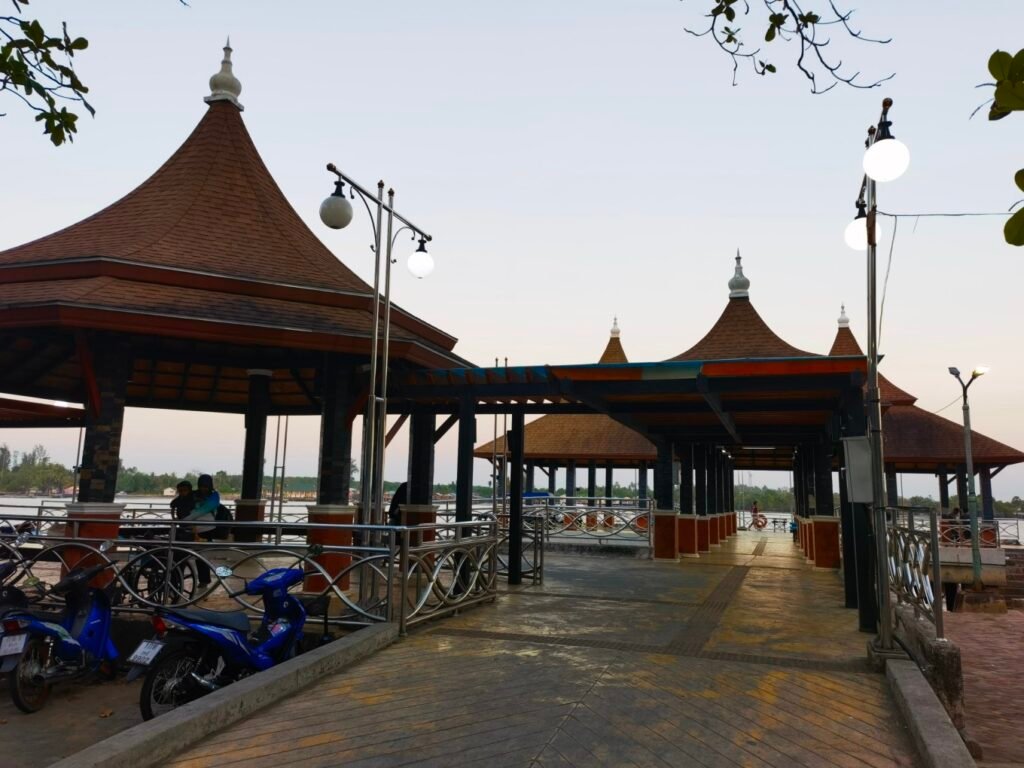
Back at Krabi’s inner river pier, the driver was waiting for us again. He mentioned that he “needs to work hard to buy formula for his kids,” and his dedication and hard work convinced me he’s a great dad. I didn’t really haggle during our interactions, and the mutual trust not only made things pleasant but also brought some unexpected good luck.
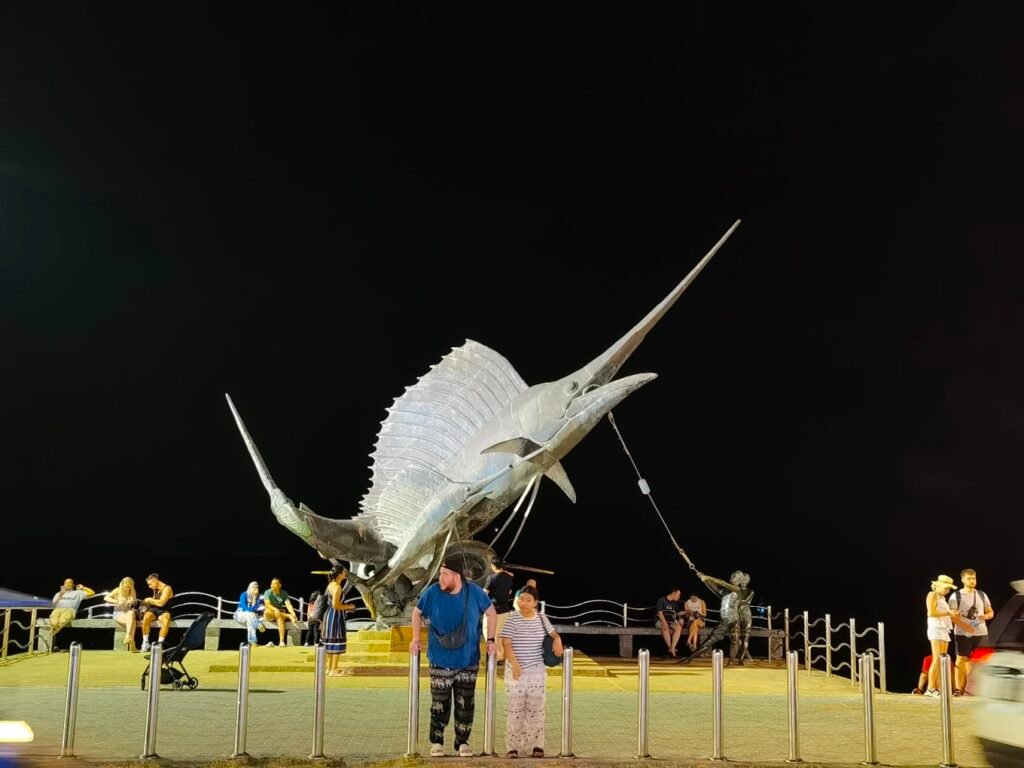


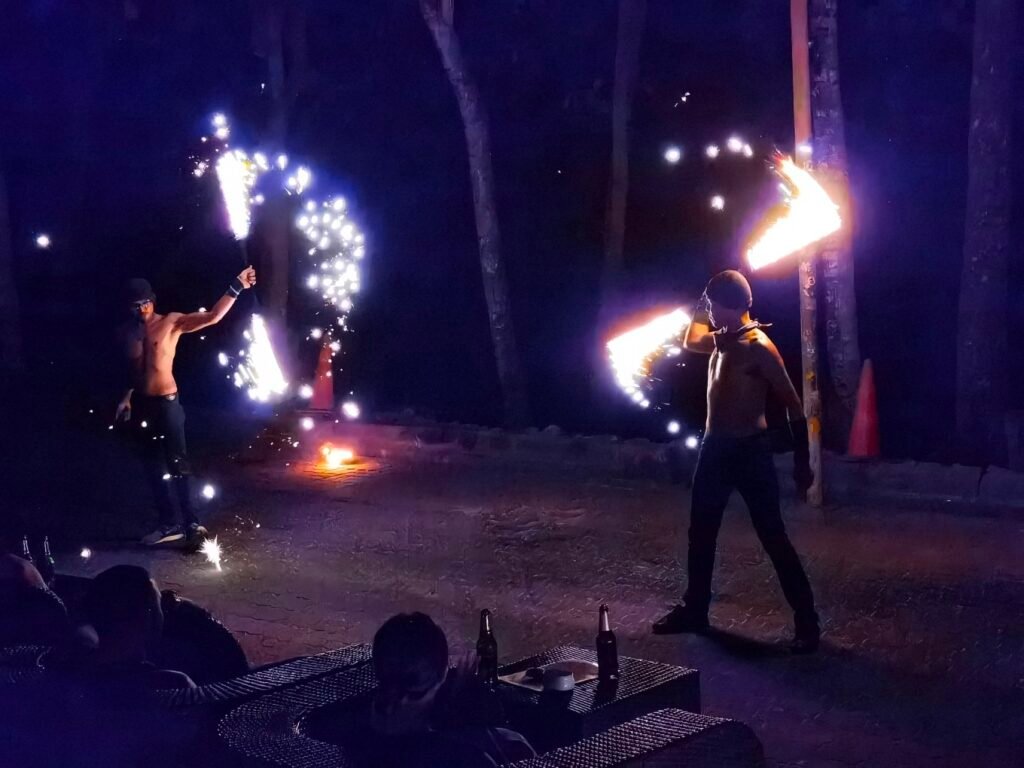
Originally, we planned to head to Railay Beach in the evening, but the songthaews on the street took us the wrong way and drove us straight to Ao Nang Night Market. After explaining the situation, they kindly took us to our intended destination for free. Local markets are obviously geared towards the residents, not tourists. They offer everything from fresh fruits, vegetables, chicken, fish, and meat to fried chicken, fried fish, sushi, kebabs, and other ready-to-eat foods, along with all kinds of clothes, shoes, and hats. In short, they have everything you need for daily life, and prices are typically half to two-thirds of those on the main streets. That’s why Thailand, with its diverse resources and high cost-performance ratio, has become the world’s most popular tourist destination—it truly deserves its reputation.



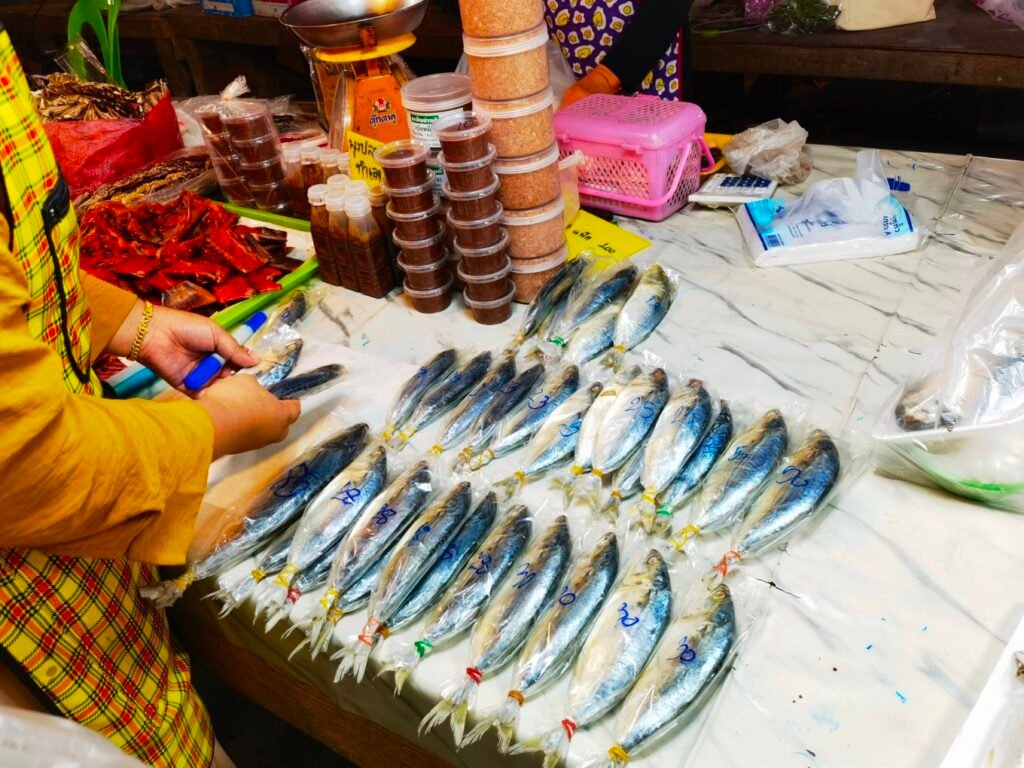
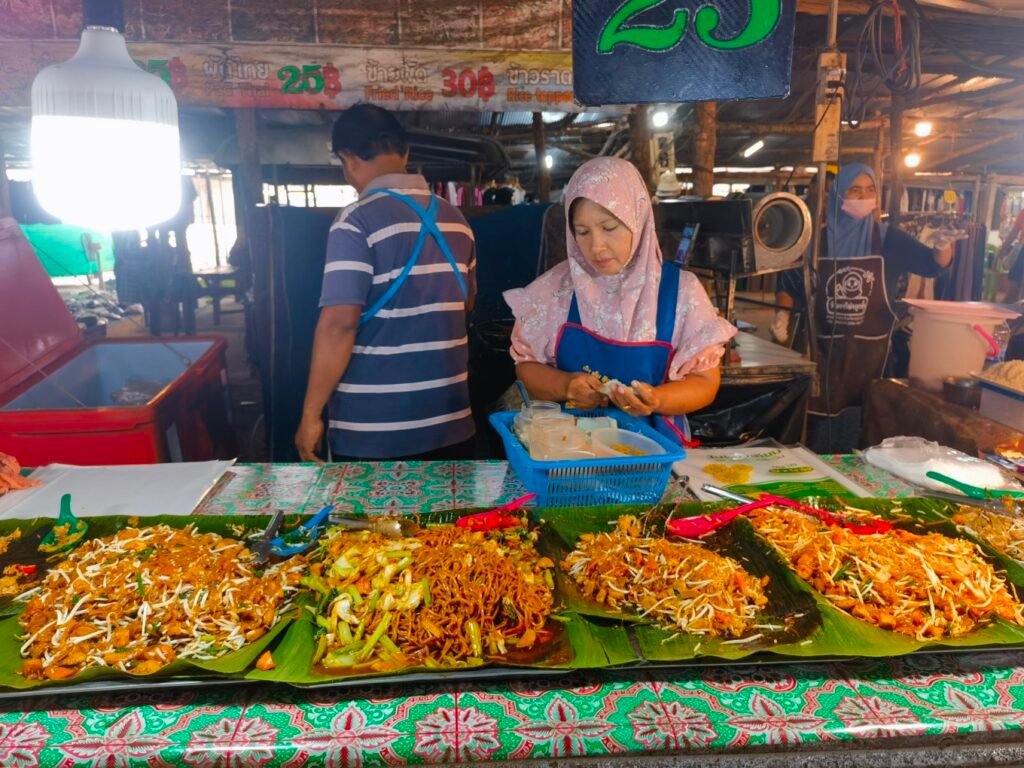

Between our hotel and the beach is just a 4-5 meter wide stone path. This path marks the intersection of Ao Nang’s main street and the pier. To the west, you’ll find all sorts of shops: beach gear, souvenirs, cosmetics, a 7-11, small restaurants, and more—it’s bustling and lively. To the east, just about 500 meters long, lies a more upscale area with various-sized and architecturally diverse resort hotels, beverage shops, a few local tour pick-up points, and massage pavilions. At the end is Monkey Tail Island, acting as a natural barrier. The eastern half of the street sees few cars but is teeming with tourists—mostly hotel guests and visitors heading to Monkey Tail Island.
Every evening around 7-8 PM near the hotel, there’s a Thai dance performance accompanied by music. Standing spectators can watch for free. Additionally, four or five well-built guys either on the beach or on the stone path put on a fireworks show right on time. They dance to energetic music while juggling flaming balls, sticks, and pillars of fire. The flames follow their vigorous movements, forming lines and shapes before exploding like a storm, enveloping them completely. All you can see are the sparks flying, with the performers vanishing from sight! The intense and strong flames perfectly blend with the vibrant and brilliant flowers at that moment, always leaving onlookers in awe and cheering! However, I noticed that after the performance, the tip hats had very few bills. Under the calm streetlights, the guys had patches of band-aids on their bodies. Life can be as happy as it is tough, and I just hope they are doing what they love.
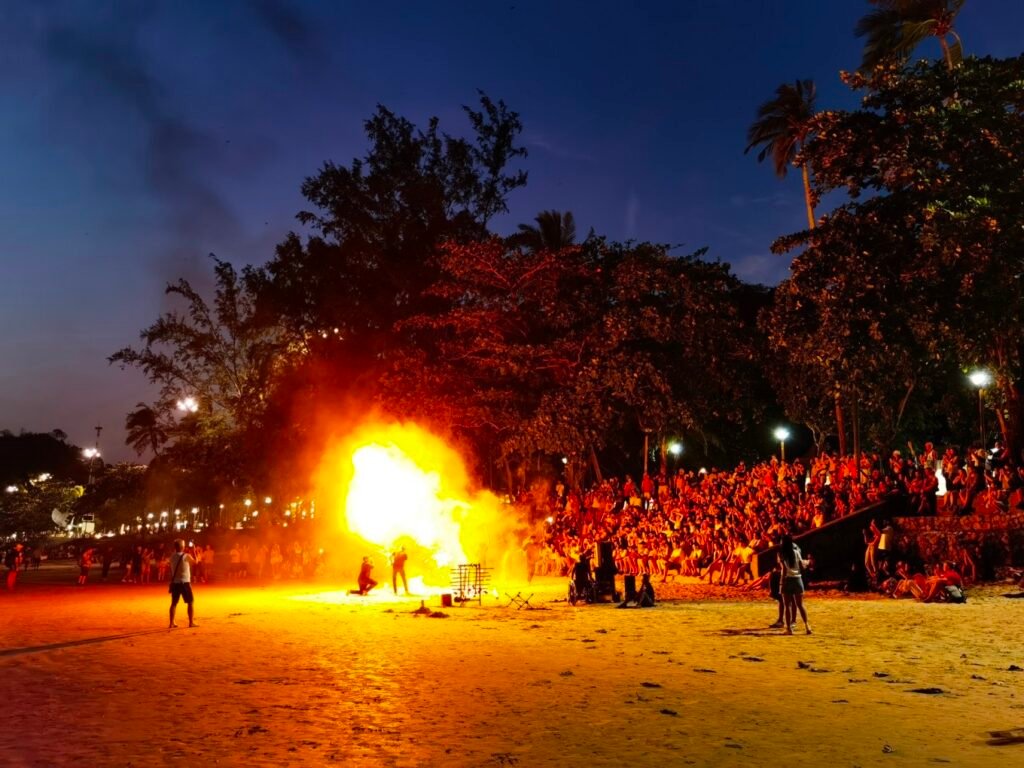
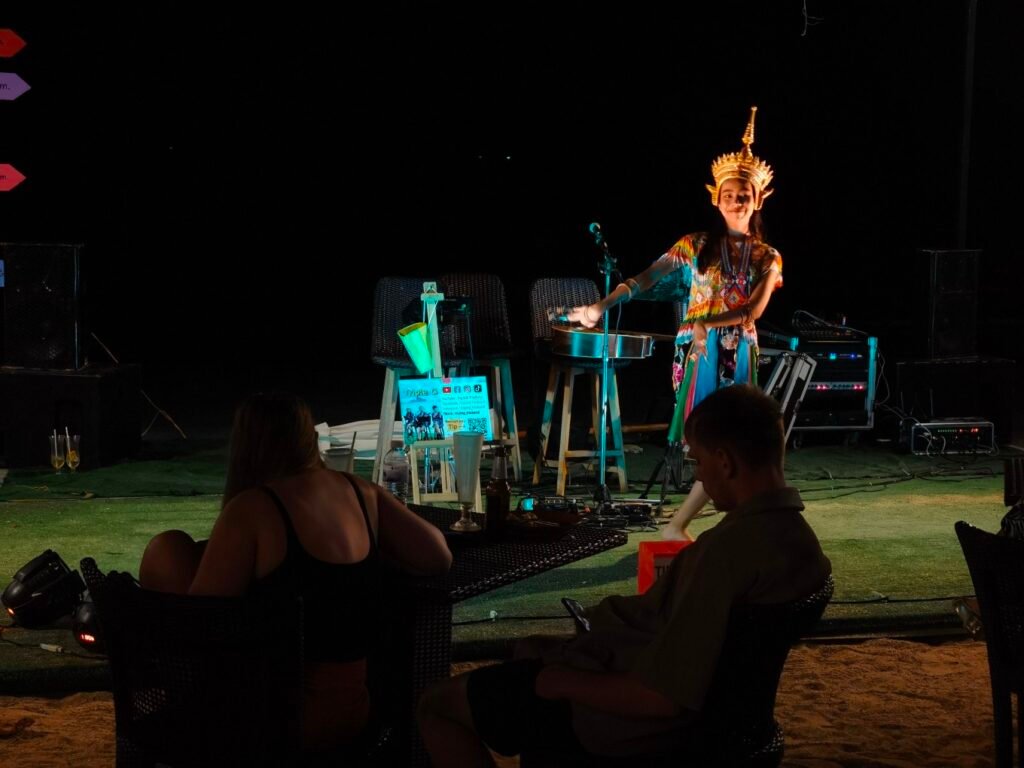
Every time I come to Thailand, I make sure to experience the local massage services. With the sea breeze blowing and the sound of waves crashing, I unknowingly drifted off to sleep. When I woke up, it was already the final stage: a foot massage. One and a half hours for 500 baht—I really have to commend Thai massages. The service is thorough, and the prices are affordable. In my opinion, the famous Thai beachside massages offer better environments and prices compared to Chinese massages, but the techniques used in Chinese massages seem more professional and scientific.
At 4 PM, I took the initiative to suggest everyone head to “Family Food” for a meal as a gesture of sincerity. This restaurant was something we found online—it seemed popular, but I wasn’t sure if it was worth it. We arrived just in time and luckily, there was a long table available for our group of seven. Looking at the menu, the prices weren’t too high or too low, and the dishes didn’t stand out as anything special. We ordered a few stir-fries and fried rice, some seafood, and hearty soups. Despite repeatedly emphasizing “NO SUGAR,” the flavors were generally acceptable, but nothing exceptional. The biggest plus was how quickly the food was served. After paying the bill, I realized I probably wouldn’t come back. It turns out that being an “internet-famous” spot just means it’s talked about a lot online—it doesn’t necessarily mean it’s great.
That evening was a perfect opportunity to stroll through the night market. However, the round-trip motorcycle taxi fares ended up costing us more than what we spent shopping at the night market. Ao Nang Night Market is slightly larger than the one in Krabi, with higher prices and a cleaner environment. Although it wasn’t particularly unique, it was bustling with tourists, and its reputation far surpassed the LOCAL MARKET we visited the day before.
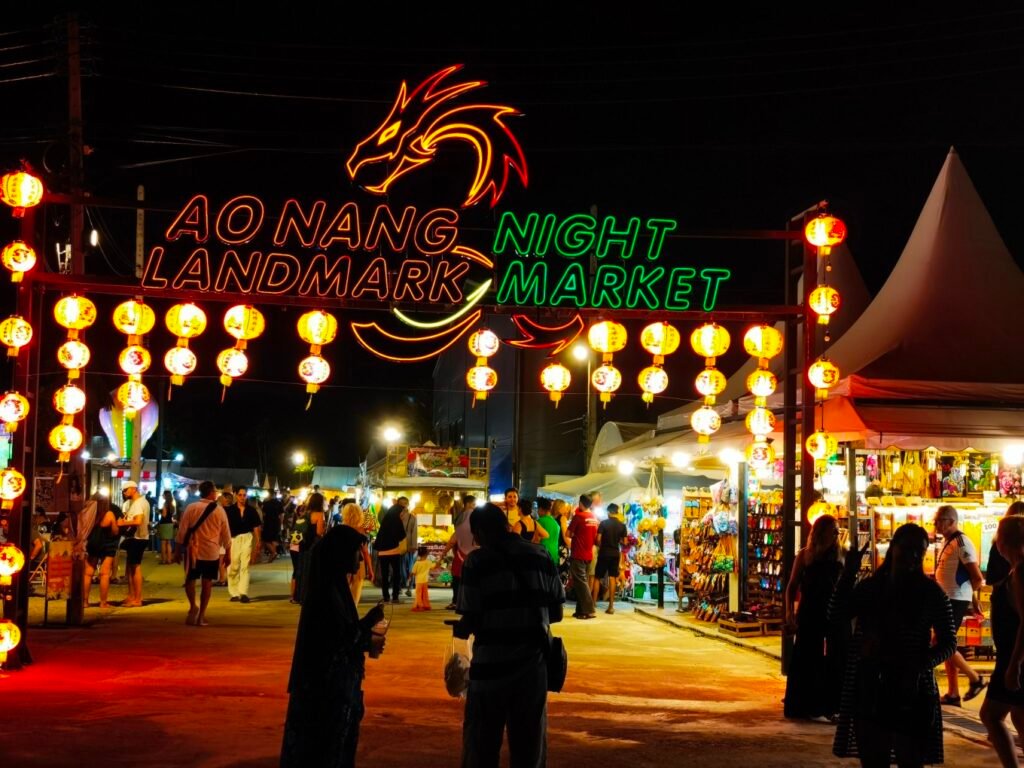

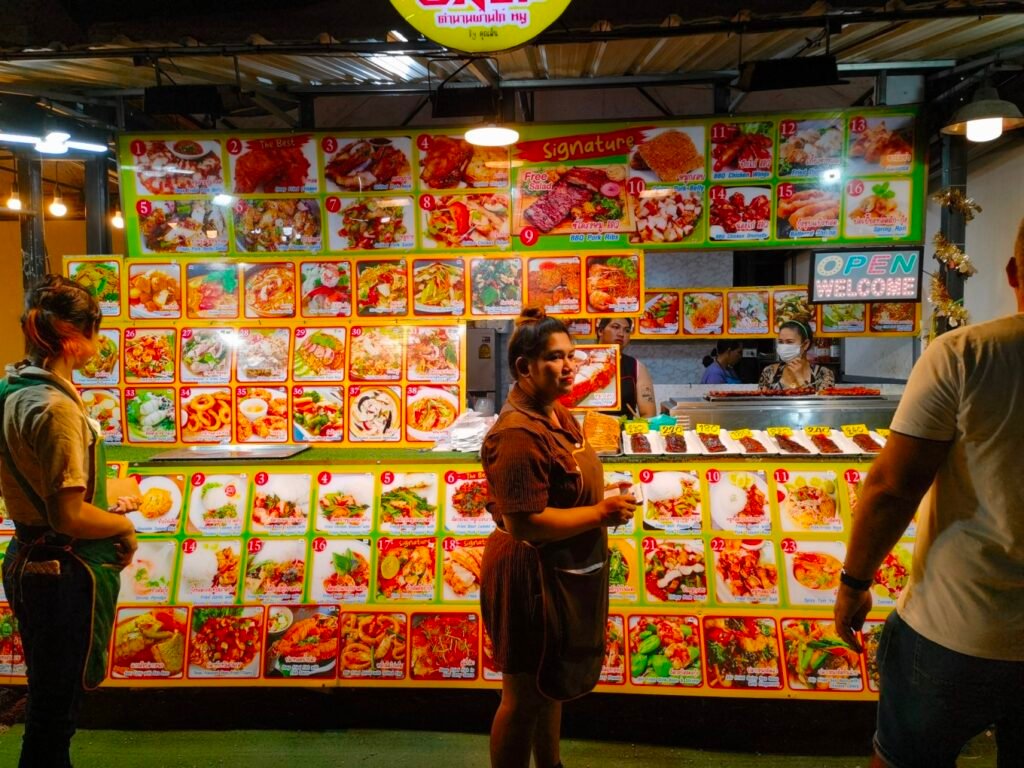

Today is our last day in Krabi, and I’ve already decided to take everyone on a long-tail boat ride to Railay Beach this evening. It’s touted as one of the world’s top ten climbing destinations, and from the photos, it’s packed with sheer cliffs and towering rocks—exactly the kind of scenery I love. The long-tail boat sails quickly, crossing over Monkey Tail Mountain on the east side of the hotel in just a few minutes. On our second day here, we had climbed up to its base, but since then, the rising tide has kept the boardwalk under the mountain submerged, so we haven’t had the chance to explore that small bay again. Sometimes, exploring brings a mix of surprises and regrets.


We circled around Monkey Tail Island, and on the sea surface, rock formations kept appearing as if they were floating—some standing alone like stalagmites, others arranged like rows of folding screens at varying heights.
In no more than 15 minutes, we arrived at Railay Beach, or more precisely, West Railay. This beach isn’t very long, just over a kilometer, and long-tail boats from Phuket, Phi Phi Island, and Ao Nang take up about one-fifth of the space. We walked around the beach, feeling that the seawater, sand, and surrounding scenery were similar to Ao Nang, so we quickly decided to head to Phra Nang Bay, the beach known for its rock climbing.
We couldn’t find any staff on the beach, and after asking several boat crew members, we finally stumbled upon the path to Phra Nang, hidden within the dense jungle between the only two resorts in Railay Bay. Along the way, there was a small convenience store with the most basic daily necessities. However, after ten minutes of walking through the forest, we reached the other side of the bay, likely East Railay. The scenery was mediocre, mainly with rough sand, and there was quite a bit of litter scattered on the beach.


We didn’t make a stop when passing East Railay. Instead, we double-checked with returning tourists about Phra Nang’s location and distance, then set off at a brisk pace, hoping to spend more time admiring Phra Nang under the sunset. The people who gave us directions always ended with, “It’s so beautiful.” Following their guidance, we were getting close to our destination. On both sides of the narrow path, towering rocky cliffs and tangled vines intertwined, and the sandy ground would sometimes meander into hollowed-out and mid-air caves. Another exit from the path led us out, with oddly shaped stone buds, pillars, and slabs dangling or hanging upside down above us. They varied in thickness and length, teetering on the brink, resembling animal heads and tails, icicles, or even plants “growing” out of the rocks! I couldn’t help but stop occasionally to take photos; words simply couldn’t capture the beauty of the green vegetation shrouding the rocky landscape.
Finally, at the end of the path, everything opened up: sheer cliffs, clear blue water, sandy beaches, and shimmering waves. The beach was only a few hundred meters long, with a few rock caves near one side of the cliffs. Some of them dipped into the sea, and many tourists were swimming and playing in the waves under the caves. We stood in silence, taking in the surrounding scenery. The golden sunset bathed the entire sea, the nearby rocky mountains, long-tail boats, and the beach in a warm glow. Everything and everyone seemed to have a golden outline, like a mirage—like a real-life fairy tale world! Maybe it was getting a bit late, but we only saw some fixed climbing ropes on the rocks, without any climbers in sight, which was a bit disappointing.
